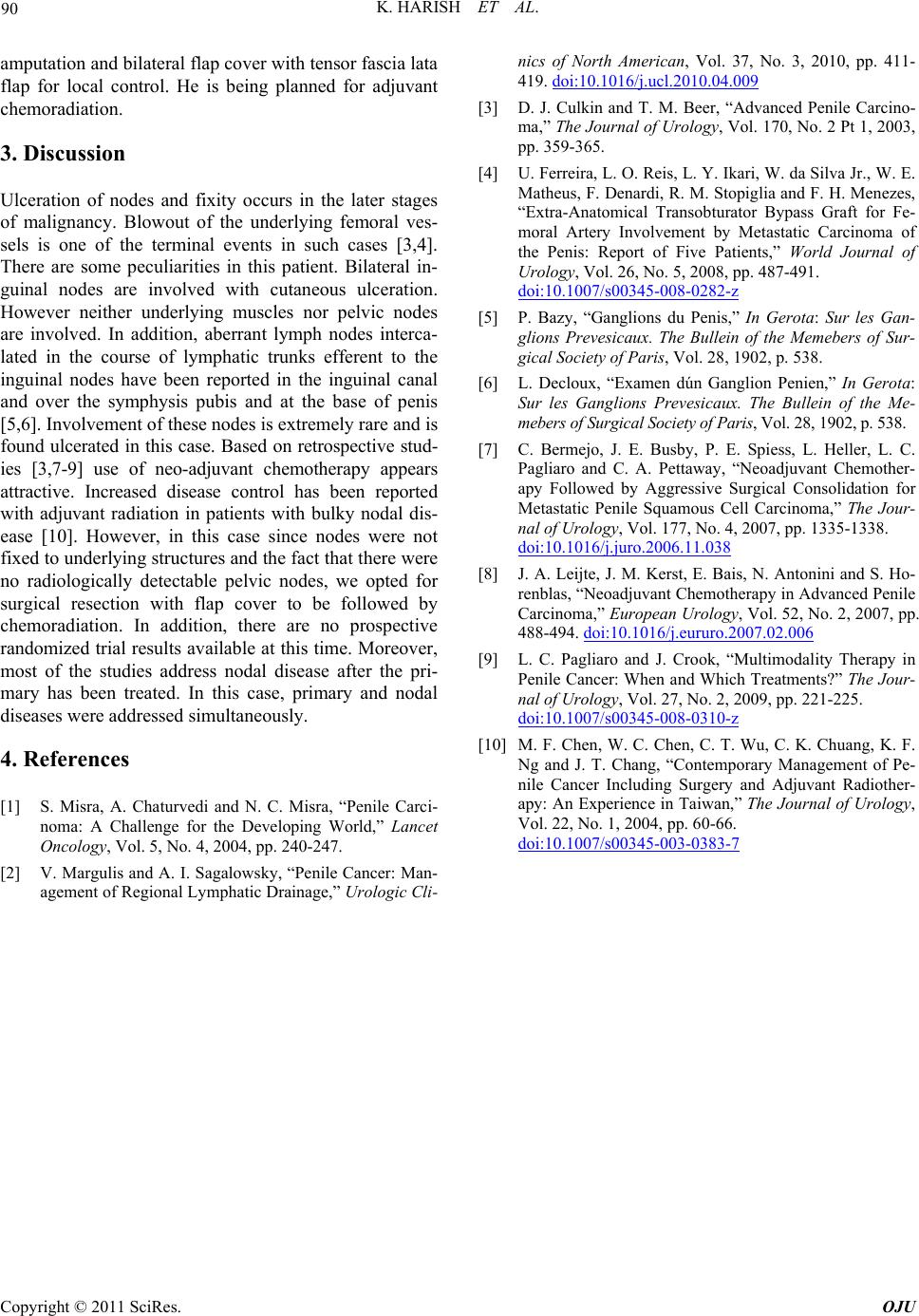
K. HARISH ET AL.
90
amputation and bilateral flap cover with tensor fascia lata
flap for local control. He is being planned for adjuvant
chemoradiation.
3. Discussion
Ulceration of nodes and fixity occurs in the later stages
of malignancy. Blowout of the underlying femoral ves-
sels is one of the terminal events in such cases [3,4].
There are some peculiarities in this patient. Bilateral in-
guinal nodes are involved with cutaneous ulceration.
However neither underlying muscles nor pelvic nodes
are involved. In addition, aberrant lymph nodes interca-
lated in the course of lymphatic trunks efferent to the
inguinal nodes have been reported in the inguinal canal
and over the symphysis pubis and at the base of penis
[5,6]. Involvement of these nodes is extremely rare and is
found ulcerated in this case. Based on retrospective stud-
ies [3,7-9] use of neo-adjuvant chemotherapy appears
attractive. Increased disease control has been reported
with adjuvant radiation in patients with bulky nodal dis-
ease [10]. However, in this case since nodes were not
fixed to underlying structures and the fact that there were
no radiologically detectable pelvic nodes, we opted for
surgical resection with flap cover to be followed by
chemoradiation. In addition, there are no prospective
randomized trial results available at this time. Moreov er,
most of the studies address nodal disease after the pri-
mary has been treated. In this case, primary and nodal
diseases were addressed simultaneously.
4. References
[1] S. Misra, A. Chaturvedi and N. C. Misra, “Penile Carci-
noma: A Challenge for the Developing World,” Lancet
Oncology, Vol. 5, No. 4, 2004, pp. 240-247.
[2] V. Margulis and A. I. Sagalowsky, “Penile Cancer: Man-
agement of Regional Lymphatic Drainage,” Urologic Cli-
nics of North American, Vol. 37, No. 3, 2010, pp. 411-
419. doi:10.1016/j.ucl.2010.04.009
[3] D. J. Culkin and T. M. Beer, “Advanced Penile Carcino-
ma,” The Journal of Urology, Vol. 170, No. 2 Pt 1, 2003,
pp. 359-365.
[4] U. Ferreira, L. O. Reis, L. Y. Ikari, W. da Silva Jr., W. E.
Matheus, F. Denardi, R. M. Stopiglia and F. H. Menezes,
“Extra-Anatomical Transobturator Bypass Graft for Fe-
moral Artery Involvement by Metastatic Carcinoma of
the Penis: Report of Five Patients,” World Journal of
Urology, Vol. 26, No. 5, 2008, pp. 487-491.
doi:10.1007/s00345-008-0282-z
[5] P. Bazy, “Ganglions du Penis,” In Gerota: Sur les Gan-
glions Prevesicaux. The Bullein of the Memebers of Sur-
gical Society of Paris, Vol. 28, 1902, p. 538.
[6] L. Decloux, “Examen dún Ganglion Penien,” In Gerota:
Sur les Ganglions Prevesicaux. The Bullein of the Me-
mebers of Surgical Society of Paris, Vol. 28, 1902, p. 538.
[7] C. Bermejo, J. E. Busby, P. E. Spiess, L. Heller, L. C.
Pagliaro and C. A. Pettaway, “Neoadjuvant Chemother-
apy Followed by Aggressive Surgical Consolidation for
Metastatic Penile Squamous Cell Carcinoma,” The Jour-
nal of Urology, Vol. 177, No. 4, 2007, pp. 1335-1338.
doi:10.1016/j.juro.2006.11.038
[8] J. A. Leijte, J. M. Kerst, E. Bais, N. Antonini and S. Ho-
renblas, “Neoadjuvant Chemotherapy in Advanced Penile
Carcinoma,” European Urology, Vol. 52, No. 2, 2007, pp.
488-494. doi:10.1016/j.eururo.2007.02.006
[9] L. C. Pagliaro and J. Crook, “Multimodality Therapy in
Penile Cancer: When and Which Treatments?” The Jour-
nal of Urology, Vol. 27, No. 2, 2009, pp. 221-225.
doi:10.1007/s00345-008-0310-z
[10] M. F. Chen, W. C. Chen, C. T. Wu, C. K. Chuang, K. F.
Ng and J. T. Chang, “Contemporary Management of Pe-
nile Cancer Including Surgery and Adjuvant Radiother-
apy: An Experience in Taiwan,” The Journal of Urology,
Vol. 22, No. 1, 2004, pp. 60-66.
doi:10.1007/s00345-003-0383-7
Copyright © 2011 SciRes. OJU